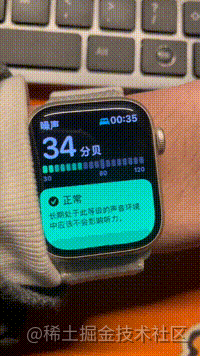前言
一直想花时间复刻一下Apple的原生UI和动画,超级丝滑。
今天,目标是AppleWatch的噪音检测音量条。
1. 页面内容分析
在上手开始前,我们不妨先仔细观察一下这个页面所涵盖的信息,再将其转换为我们的业务需求,提前整理好思路再开始上手写。
1.1 静态布局

我们首先来看看上方图片里都涵盖了什么细节:
- 噪声动画条由18个圆角矩形(记为unitRect)组合拼接完成
- 整个动画条覆盖30dB~120dB
- 每个圆角矩形的单位dB为5
- dB为80的圆角矩形的height值更大一些
- 噪声动画条左侧为绿色/黄色,代表分贝的值,其余为默认色
有了以上细节,我们来初步设想一下该怎么实现:
- 静态动画条:这个好说,用canvas.drawRoundRect()来画出带有corner圆角的矩形就好啦;画18个,其中第10个我们调高他的height,就可以实现初步的效果了。
- 动画条颜色:我们可以将当前的分贝设置为这个组件的输入值(记为currentDb),通过currentDb来计算,有多少个单元格(unitRect)需要被标记为有色,其他的被设定为默认的无色;
1.2 动态效果

同样,我们再来看一下上方GIF里的动画效果
- 颜色变化:分贝低于80,为绿色;分贝高于80,转为黄色
- 动画条变化:分贝值改变后,动画条需要呈现出柔滑的过渡效果
首先,两个动态变化的效果可以被转化为以下两个需求:
- 颜色变化:对我们的组件的输入值currentDb进行条件判断,如果>80,我们就将有色单元格(unitRect)的颜色设定为黄色,否则为绿色。
- 动画条变化:为了能够实现柔滑的动画条变化,我们不难想到,在创建自定义View后,用objectAnimator,针对currentDb来执行一个动画,让旧的分贝值逼近到新的分贝值,从而实现一个过渡效果。
音量条动态过渡效果举例:
- 假设我们的音量条当前的分贝值是40,有2个单元格为绿色,其余是灰色;
- 现在,我们音量条获得了一个新的分贝值:70,这需要有8个单元格变成绿色;
- 我们假设这个动画需要在120ms内以线性的过渡效果完成完成:新增的6个绿色单元格就会在这120ms内被逐步填充,也就是20ms一个单元格,以此实现了动画的过渡。
但,如果我们希望能够实现更顺滑的效果:
- 那就再添加一个类型的单元格:过渡单元格
- 过渡单元格用透明度高一些的颜色来进行绘制
- 随后,给我们的组件引入一个新的变量:lastDb,用于表示上一刻的分贝值
- currentDb与lastDb的差值的绝对值,用于表示当前正在变化过程中的数值,用于计算过渡单元格的数量
- 最后,我们再使用objectAnimator来让lastDb逐步逼近currentDb以实现更丝滑的过渡效果✌
2. 自定义View登场
强大的自定义view来了,这个音量条只需要一些最基础的功能即可完成绘制,下面就只放最核心的代码。
2.1 绘制
- 我们需要以下5种颜色:
- 默认色:灰色
- 低分贝的绿色以及过渡用的透明绿色
- 高分贝的黄色以及过渡用的透明黄色
var colorGreen = Color.parseColor("#FF0FDD72")
var colorParentGreen = Color.parseColor("#660FDD72")
var colorYellow = Color.parseColor("#FFFFE620")
var colorParentYellow = Color.parseColor("#66FFE620")
var colorDefault = Color.parseColor("#FF4C4C4C")- 单元格的尺寸以及总尺寸
这里的比例是我把AppleWatch的截图放进figma测量了一下,也可以自己定夺。
//Width of total View
totalWidth = (width - paddingLeft - paddingRight).toFloat()
//Height of unitRect
secondHeight = totalWidth / 1050 * 96
//Height of total view
totalHeight = totalWidth / 1050 * 129
//Height of highUnitRect
highUnitHeight = totalWidth / 1050 * 120
//Width of unitRect
unitWidth = totalWidth / 1050 * 50
//space between unitRects
space = totalWidth / 1050 * 8
//corner of the rectangle
corner = 4F
val leftBound = center.first - totalWidth / 2
val unitUpperBound = center.second - secondHeight / 2
val unitLowerBound = center.second + secondHeight / 2
val highUnitUpperBound = center.second - highUnitHeight / 2
val highUnitLowerBound = center.second + highUnitHeight / 2- 不同的分贝对应不同的颜色组合
80分贝以上,我们把Paint转换为黄色,这里我使用一个Pair打包起来:
colorPair = if (currentDb < 80) {
Pair(colorGreen, colorParentGreen)
} else {
Pair(colorYellow, colorParentYellow)
}- 计算不同类型单元格的数量:
我们的三种类型单元格:
- 有色单元格:表示上一刻的分贝
- 透明色单元格:表示过渡模块
- 灰色单元格:默认色
//有色单元格
val numOfColor:Int = ((min(lastDb, currentDb) - 30) / 5)
//过渡单元格
val numOfChangingColor:Int = abs(currentDb - lastDb) / 5- 循环开画,画18个:
- 首先,判断下当前的index,如果是处于有色块区间,paint则调整为color Pair的第一个值,如果是过渡块区间,就设置成透明的颜色;剩下的都是默认色。
- 其次,如果我们到了第10个,也就是表示80分贝的 highUnitRect,就让这个rect拥有更高的height。
for (index in 0..17) {
//change paint color according to current index
if (index < numOfColor) {
soundPaint.color = colorPair.first
} else if (index < numOfColor + numOfChangingColor) {
soundPaint.color = colorPair.second
} else {
soundPaint.color = colorDefault
}
//if index ==10, draw highUnit
var thisLeftBound = leftBound + space * (index + 1) + index * unitWidth
if (index == 10) {
canvas?.drawRoundRect(
thisLeftBound,
highUnitUpperBound,
thisLeftBound + unitWidth,
highUnitLowerBound,
corner, corner, soundPaint
)
} else {
canvas?.drawRoundRect(
thisLeftBound,
unitUpperBound,
thisLeftBound + unitWidth,
unitLowerBound,
corner, corner, soundPaint
)
}
}到这里,我们的onDraw方法就完成了,我们拥有了如下的默认效果。
分贝>=80:

分贝<80:

2.2 柔滑的动画过渡效果
激动人心的时刻来了,让它动起来:
- 首先,别忘了添加style xml文件让它可以获取外部参数:这里我们暂时只设置lastDb和currentDb,其他的颜色可以自己定义。
在构造器里初始化一下我们的两个音量参数
constructor(context: Context, attrs: AttributeSet) : super(context, attrs) {
val styleArray = context.obtainStyledAttributes(attrs, R.styleable.NoiseSplineView)
currentDb = styleArray.getInt(R.styleable.NoiseSplineView_currentDb, 60)
lastDb = styleArray.getInt(R.styleable.NoiseSplineView_lastDb, 40)
styleArray.recycle()- 接着,我们在layout的xml文件中创建这个自定义的组件,并给它添加ObjectAnimator动画:像之前所说的,我们通过让lastDb来不断逼近以实现柔滑的过渡效果!
//全局变量存储上一刻与当前时刻的dB
lateinit var currentDb:Int
lateinit var lastDb:Int
//这个函数接受一个参数,设置音量条的currentDb与lastDb,并执行动画。
fun setSoundDataAndAnimate(noiseDb: Int) {
//接收音量参数,更新我们的currentDb
currentDb = noiseDb
noiseSpline?.currentDb = currentDb
noiseSpline?.lastDb = lastDb
//创建ofInt动画,让lastDb不断逼近currentDb
var noiseAnimator = ObjectAnimator.ofInt(noiseSpline, "lastDb", lastDb, currentDb)
noiseAnimator?.interpolator = AccelerateDecelerateInterpolator()
//用先加速后减速的插值器,当然也可以替换成别的!
noiseAnimator?.start()
//保存当前时刻的音量,存储进lastDb
lastDb = currentDb
}3. 效果预览
最后,我们终于获得了这个音量条组件,现在我们创建一个子线程来以700ms一次的频率来看一下动画效果。

最后最后,再来看一下慢放下的动画效果,lastDb是否按我们的预期不断逼近currentDb了?

嗯,和预想的一样,收工。
4. 附-代码
File 1: NoiseSplineView.kt
import android.annotation.SuppressLint
import android.content.Context
import android.graphics.Canvas
import android.graphics.Color
import android.graphics.Paint
import android.util.AttributeSet
import android.view.View
import isense.com.R
import kotlin.math.abs
import kotlin.math.min
import kotlin.properties.Delegates
class NoiseSplineView : View {
var totalWidth = 1050F
var secondHeight = 96F
var totalHeight = 129F
var highUnitHeight = 120F
var unitWidth = 50F
var space = 8F
var corner = 12F
var currentDb = 30
set(value) {
invalidate()
field = value
}
var lastDb = 40
set(value) {
invalidate()
field = value
}
var backGroundPaint = Paint()
var soundPaint = Paint()
val totalAmount = 18
var center by Delegates.notNull<Float>()
lateinit var colorPair: Pair<Int, Int>
var colorGreen = Color.parseColor("#FF0FDD72")
var colorParentGreen = Color.parseColor("#660FDD72")
var colorYellow = Color.parseColor("#FFFFE620")
var colorParentYellow = Color.parseColor("#66FFE620")
var colorDefault = Color.parseColor("#FF4C4C4C")
constructor(context: Context) : super(context, null, 0) {
}
constructor(context: Context, attrs: AttributeSet) : super(context, attrs) {
val styleArray = context.obtainStyledAttributes(attrs, R.styleable.NoiseSplineView)
currentDb = styleArray.getInt(R.styleable.NoiseSplineView_currentDb, 60)
lastDb = styleArray.getInt(R.styleable.NoiseSplineView_lastDb, 40)
styleArray.recycle()
initNoiseSpline()
}
constructor(context: Context, attrs: AttributeSet, defStyleAttr: Int) : super(context, attrs, defStyleAttr) {
initNoiseSpline()
}
constructor(context: Context, attrs: AttributeSet, defStyleAttr: Int, defStyleRes: Int) : super(
context,
attrs,
defStyleAttr,
defStyleRes
) {
initNoiseSpline()
}
@SuppressLint("DrawAllocation")
override fun onDraw(canvas: Canvas?) {
super.onDraw(canvas)
//Width of total View
totalWidth = (width - paddingLeft - paddingRight).toFloat()
//Height of unitRect
secondHeight = totalWidth / 1050 * 96
//Height of total view
totalHeight = totalWidth / 1050 * 129
//Height of highUnitRect
highUnitHeight = totalWidth / 1050 * 120
//Width of unitRect
unitWidth = totalWidth / 1050 * 50
//space between unitRects
space = totalWidth / 1050 * 8
//corner of the rectangle
corner = 4F
var center = Pair(width / 2, height / 2)
colorPair = if (currentDb < 80) {
Pair(colorGreen, colorParentGreen)
} else {
Pair(colorYellow, colorParentYellow)
}
val leftBound = center.first - totalWidth / 2
val unitUpperBound = center.second - secondHeight / 2
val unitLowerBound = center.second + secondHeight / 2
val highUnitUpperBound = center.second - highUnitHeight / 2
val highUnitLowerBound = center.second + highUnitHeight / 2
var numOfColor = ((min(lastDb, currentDb) - 30) / 5)
var numOfChangingColor = abs(currentDb - lastDb) / 5
for (index in 0..17) {
//change paint color
if (index < numOfColor) {
soundPaint.color = colorPair.first
} else if (index < numOfColor + numOfChangingColor) {
soundPaint.color = colorPair.second
} else {
soundPaint.color = colorDefault
}
//if index ==10, draw highUnit
var thisLeftBound = leftBound + space * (index + 1) + index * unitWidth
if (index == 10) {
canvas?.drawRoundRect(
thisLeftBound,
highUnitUpperBound,
thisLeftBound + unitWidth,
highUnitLowerBound,
corner, corner, soundPaint
)
} else {
canvas?.drawRoundRect(
thisLeftBound,
unitUpperBound,
thisLeftBound + unitWidth,
unitLowerBound,
corner, corner, soundPaint
)
}
}
}
override fun onMeasure(widthMeasureSpec: Int, heightMeasureSpec: Int) {
super.onMeasure(widthMeasureSpec, heightMeasureSpec)
var width = measureDimension(totalWidth.toInt(), widthMeasureSpec)
var height = measureDimension(totalHeight.toInt(), heightMeasureSpec)
setMeasuredDimension(width, height)
}
fun measureDimension(defaultSize: Int, measureSpec: Int): Int {
var result = defaultSize
var specMode = MeasureSpec.getMode(measureSpec)
var specSize = MeasureSpec.getSize(measureSpec)
if (specMode == MeasureSpec.EXACTLY) {
result = specSize
} else {
result = defaultSize
if (specMode == MeasureSpec.AT_MOST) {
result = min(result, specSize)
}
}
return result
}
private fun initNoiseSpline() {
soundPaint.strokeWidth = 0F
soundPaint.style = Paint.Style.FILL_AND_STROKE
soundPaint.apply {
isAntiAlias = true
isDither = true
isFilterBitmap = true
}
}
}File 2: noiseSplineAttr.xml
<?xml version="1.0" encoding="utf-8"?>
<resources>
<declare-styleable name="NoiseSplineView">
<attr name="currentDb" format="integer"/>
<attr name="lastDb" format="integer"/>
</declare-styleable>
</resources>



















